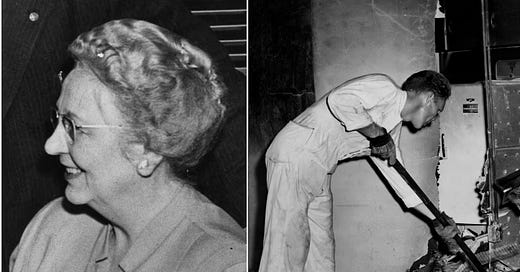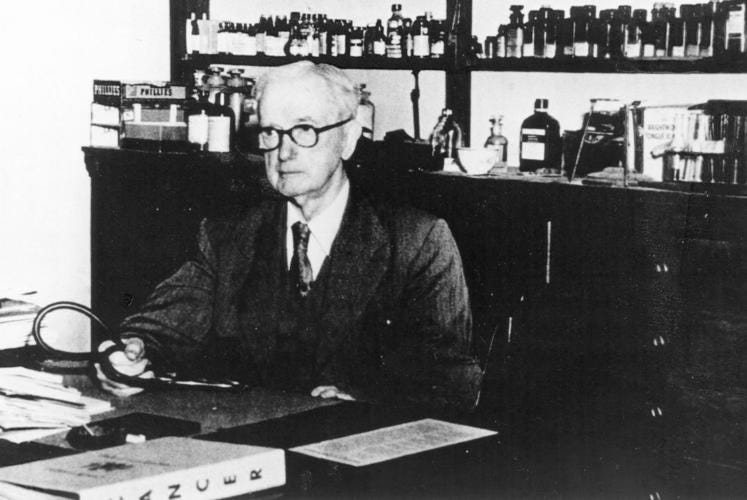The Mysterious Deaths of Mary Reeser and John Irving Bentley - America's Infamous 'Spontaneous Human Combustion' Cases
For both Reeser and Bentley, among the only remains found was the intact lower part of their leg, with the shoe still on.
Although Mary Reeser and John Irving Bentley never knew of the other and died fifteen years apart, history has been placing them in the same category for the past sixty years - U.S. citizens who died a mysterious death, thought to be “mysterious self-immolation” or spontaneous human combustion (SHC). If you’ve never heard of spontaneous human combustion, it’s not because you live under a rock. SHC is a phenomenon that is mostly rebuked and harshly criticised by the medical community. Having lived with a medical professional most of my life, I probed my mother into her thoughts about SHC, only to be told that “such a thing is scientifically impossible.” That, however, hasn’t stopped me from considering the possibility that Resser and Bentley might have actually died by spontaneously catching on fire and wonder could it happen to me one day, too.
As the name suggests, spontaneous human combustion is considered as a pseudoscientific phenomenon where a person (both living or deceased) spontaneously bursts into flames without any external source of fire. The first official case of SHC was recorded in 1731 when an Italian noblewoman, Cornelia Zangari Bandi was found dead in her bed with only her lower leg left remaining. The earliest supposed case dates back to 1470 when Polonus Vortstius burst into flames after drinking all night. According to Larry E. Arnold, a researcher in paranormal deaths, over the past three hundred years, about two hundred cases of SHC have been recorded. Among the victims of SHC, certain common characteristic have been found:
victims were alcoholics
most were elderly women
the body didn’t just combust, but a lighted source came in contact with it
lower leg parts were mostly intact, often with shoes still on
the surrounding area was unaffected by flames
For both Reeser and Bentley, there is little to no information about their lives leading up to their deaths. At the time of her death, Reeser was 67, and Bentley 92. Reeser had been discovered by her landlady, stating the doorknob to her apartment was “impossibly warm” and called the police to examine the scene. The only remains found were her lower left foot with the slipper still on, a section of her thoracic spine, and her skull that shrank to the size of “a teacup” (Blizin 14). The police chief in St. Petersburg, Florida, who worked on the case sent a note the the FBI director at the time requesting “any information or theories that could explain how a human body could be so destroyed, and the fire confined to such a small area and so little damage done to the structure of the building and the furniture (…)” (Calise).
Bentley had been found by his meter reader who noticed an unusual smell and smoke upon entering the house. In the basement, he discovered a pile of ashes that came from the room above - Bentley’s bathroom. Bentley was found dead in the bathroom with only his lower right foot found at the scene, and his ashes residing in the basement. Upon inspection, the police found the rest of the room to have been left intact.
Both cases were thoroughly investigated and considered as cases of the “wick” and “stack” effect, respectively. The wick effect is considered as the official cause of Mary Reeser’s death, which happens when a section of the human body, or its entirety, burn down due to the victim’s clothes soaking up human fat which aids the burning. As is the case with many supposed victims of SHC, a large number of people found spontaneously burned alive were overweight. Mary Reeser fell into that category. Moreover, Reeser was a smoker. Her daughter-in-law gave an interview following the accident and said she strongly believed a lit cigarette might've caused the fire which, ultimately, killed Reeser.
The stack effect, believed to have caused John Irving Bentley’s death, describes the flow of air in and out of a building through unsealed or intentionally designed openings, driven by buoyancy forces. Based on Joe Nickell’s book Secrets of the Supernatural, Bentley was smoking a pipe at the time of his death. His burned robe was found in the bathtub. It is likely Bentley accidentally dropped some hot ashes from his pipe on them, which caused them to catch on fire. To make matters worse, he had lighting matches in his pocket which likely caused the fire to spread and engulf the man, too. Due to the heat, the linoleum floor of his bathroom gave out and created a hole which aided the stack effect - the cold air from the basement further kindled the fire.
Although SHC is today mostly regarded as a conspiracy theory into the deaths of Reeser, Bentley and many others who perished in this strange way, interest in this matter remains strong. Exactly because it has never been officially disproven since it never happened right in front of someone, pop culture has adopted the idea of SHC into many faucets of contemporary culture - movies, series, books, video games and music. Back in 1853, Charles Dickens released Bleak House in which one of the characters dies of SHC. Parasite Eve, a video-game from 1998 opens by having the entire audience of Carnegie Hall spontaneously combust. South Park, the adult animated series dedicated an entire episode to SHC.
Regardless of what one believes in, just like going down the rabbit hole to learn about certain conspiracy theories, considering that SHC might actually be possible is entertaining and frightening, all at the same time. The mere inexplicability of this phenomenon has rendered those interested in it almost desensitised to the deaths behind it, but not ignorant of it. In some twisted way, because of how they died, the people who supposedly passed away due to SHC are likely to remain part of the collective memory of paranormal “hunters”, tied to an occurrence that cannot be explained by medicine, physics or chemistry. But after all, the absence of evidence is not the evidence of absence.





